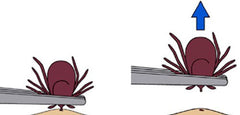Tick ID and Removal Tips
Posted by Animal Care Team on
Does it seem like ticks are worse than usual this year? You’re not crazy – experts warn that 2024 is an above-average year for tick activity, thanks in part to a mild winter in many areas of the U.S.
Spring has sprung, which means an increase in outdoor activities like trail rides, hikes, and backyard gatherings. The problem is it is not just us humans and our pets who are out and about – so are ticks. And for those of us who experienced a mild winter, we are seeing more of the nasty critters earlier than ever. Besides being ugly and creepy, we know that ticks can bite and transmit blood borne diseases like Lyme disease and anaplasmosis.
Identifying Ticks
Depending on your location in the country, certain types of ticks are more prevalent than others. Two of the most common varieties are the American Dog Tick and the Blacklegged (otherwise known as Deer) Tick. The dog tick tends to be slightly larger (up to about a quarter of an inch when full grown) and have brown narrow-shaped bodies; they are able to live indoors for their entire life cycle if given the opportunity. Deer ticks are very small; adults are only about the size of a sesame seed, have a red-orange body and eight dark legs. For pictures and more detail around where specific ticks live and the diseases they carry, check out this article on absorbine.com.
While both can create health issues with their bites, the deer tick carries the threat of lyme disease. Don’t be fooled by their names – both can feed off a variety of hosts including humans. Tick lifecycles average 2-3 years, going through several life stages, and must have a blood meal at every stage to survive AND need a new host at every stage of their life.
Yup. Nasty and yucky.

Checking For Ticks
While there are numerous ways to do our best to prevent tick bites including using repellents like UltraShield® Green Natural Insect Repellent, avoiding grassy and wooded areas, or implementing better pasture management, the fact is ticks happen. Keep an eye out for them on your pets and yourself while spending any time outdoors. When they first hop on, before they latch, you can often brush them off before they have had the chance to claim their newest host. After every outing, do a thorough inspection - any area that may have been brushing up against grasses. This can be a bit more challenging with pets with dark fur, or for bigger animals like horses – best to use bright light and use your hands to feel for the telltale lumps.
Where do ticks like to attach? You should always check your pet’s whole body, but here are some common areas you’ll find ticks on your four-legged friends.
On Horses: Chest, underbelly, mane, tail, legs, and in & around their flank
Dogs & Cats: Ears, tail, between their toes, or under the front and back legs


Removal
There are many stories and bits of advice about how to remove ticks that have latched onto skin – everything from using nail polish or petroleum jelly, to using heat to get the tick to “back out”. It is best to avoid all of those remedies, as the goal is to remove the tick as quickly as possible, not wait for it to detach – plus, those options can carry their own risks.
The best way to remove a tick is to use clean, fine-tipped tweezers to grab the tick as close to the skin’s surface as possible. Pull upward with steady, even pressure without twisting. Pulling steady and straight is the best potential for removing the whole insect, including the mouth-part of the tick. Dispose of the tick by putting it in alcohol, wrap it tightly in tape or flush it down the toilet. After removing the tick, clean the bite area and your hands, then add a bit of Silver Honey® Ointment to reduce the potential of secondary infection from bacteria and help soothe any discomfort.
Symptoms
Always keep an eye on your horse or pet for any signs of lethargy, lameness, rash, or change in behavior or appetite. If they exhibit any of these symptoms, see your vet as soon as possible. Signs of tickborne illness may not appear for 7 – 21 days or longer after a tick bite. Lyme disease can take 5-16 weeks from the initial bite for symptoms to appear. This is why finding the ticks early and if your veterinarian advises, treating with antibiotics right away is critical.
For additional helpful information and tips about these annoying pests, visit the CDC’s website and prepare yourself and your furry family members for a fun spring and summer full of adventure.
